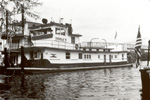|
General Lew Wallace Study
The General Lew Wallace Study & Museum, formerly known as the Ben-Hur Museum, is located in Crawfordsville, Indiana. It was declared a National Historic Landmark in 1976, and in 2008 was awarded a National Medal from the federal Institute of Museum and Library Services. It is located in the Elston Grove Historic District. The museum is associated with the life of Lew Wallace and his 1880 novel '' Ben-Hur: A Tale of the Christ''. The study, designed by Wallace, and accompanying carriage house are the only structures pertaining to Lew Wallace that have retained historical integrity. Both of these buildings now make up the museum and exhibit many of the artifacts that Wallace used during his lifetime, as well as many objects pertaining to his literary legacy.Adams Sec. 7, p. 1 Guided tours of the study are available for a small admission fee; the Carriage House Interpretive Center and grounds are open to the public free of charge. History Lew Wallace is most famous for his military ... [...More Info...] [...Related Items...] OR: [Wikipedia] [Google] [Baidu] |
Crawfordsville, Indiana
Crawfordsville is a city in Montgomery County in west central Indiana, United States, west by northwest of Indianapolis. As of the 2020 census, the city had a population of 16,306. The city is the county seat of Montgomery County, the only chartered city and largest populated place in the county. Crawfordsville is part of a broader Indianapolis combined statistical area, although the Lafayette metropolitan statistical area is only north. It is home to Wabash College, which was ranked by ''Forbes'' as #12 in the United States for undergraduate studies in 2008. The city was founded in 1823 on the bank of Sugar Creek, a southern tributary of the Wabash River and named for U.S. Treasury Secretary William H. Crawford. History Early 19th century In 1813, Williamson Dunn, Henry Ristine, and Major Ambrose Whitlock, U.S. Army, noted that the site of present-day Crawfordsville was ideal for settlement, surrounded by deciduous forest and potentially arable land, with water provided b ... [...More Info...] [...Related Items...] OR: [Wikipedia] [Google] [Baidu] |
National Historic Landmarks In Indiana
National Historic Landmarks in Indiana represent Indiana's history from the Native American era to its early European settlers and motor racing. There are 43 National Historic Landmarks (NHLs) in the state, which are located in 23 of its 92 counties. They illustrate the state's industrial and architectural heritage, as well as battles, circuses, education, and several other topics. One of the NHLs in the state has military significance, fourteen are significant examples of different architectural styles, nine are associated with significant historical figures, and one is an archaeological site. Two NHL properties, both ships that were formerly located in Indiana, were later moved to another state. The National Historic Landmark Program is administered by the National Park Service, a branch of the Department of the Interior. The National Park Service determines which properties meet NHL criteria and makes nomination recommendations after an owner notification process. The Secretar ... [...More Info...] [...Related Items...] OR: [Wikipedia] [Google] [Baidu] |
Turkey
Turkey ( tr, Türkiye ), officially the Republic of Türkiye ( tr, Türkiye Cumhuriyeti, links=no ), is a list of transcontinental countries, transcontinental country located mainly on the Anatolia, Anatolian Peninsula in Western Asia, with a East Thrace, small portion on the Balkans, Balkan Peninsula in Southeast Europe. It shares borders with the Black Sea to the north; Georgia (country), Georgia to the northeast; Armenia, Azerbaijan, and Iran to the east; Iraq to the southeast; Syria and the Mediterranean Sea to the south; the Aegean Sea to the west; and Greece and Bulgaria to the northwest. Cyprus is located off the south coast. Turkish people, Turks form the vast majority of the nation's population and Kurds are the largest minority. Ankara is Turkey's capital, while Istanbul is its list of largest cities and towns in Turkey, largest city and financial centre. One of the world's earliest permanently Settler, settled regions, present-day Turkey was home to important Neol ... [...More Info...] [...Related Items...] OR: [Wikipedia] [Google] [Baidu] |
Frieze
In architecture, the frieze is the wide central section part of an entablature and may be plain in the Ionic or Doric order, or decorated with bas-reliefs. Paterae are also usually used to decorate friezes. Even when neither columns nor pilasters are expressed, on an astylar wall it lies upon the architrave ("main beam") and is capped by the moldings of the cornice. A frieze can be found on many Greek and Roman buildings, the Parthenon Frieze being the most famous, and perhaps the most elaborate. This style is typical for the Persians. In interiors, the frieze of a room is the section of wall above the picture rail and under the crown moldings or cornice. By extension, a frieze is a long stretch of painted, sculpted or even calligraphic decoration in such a position, normally above eye-level. Frieze decorations may depict scenes in a sequence of discrete panels. The material of which the frieze is made of may be plasterwork, carved wood or other decorative medium. ... [...More Info...] [...Related Items...] OR: [Wikipedia] [Google] [Baidu] |
Garnet
Garnets () are a group of silicate minerals that have been used since the Bronze Age as gemstones and abrasives. All species of garnets possess similar physical properties and crystal forms, but differ in chemical composition. The different species are pyrope, almandine, spessartine, grossular (varieties of which are hessonite or cinnamon-stone and tsavorite), uvarovite and andradite. The garnets make up two solid solution series: pyrope-almandine-spessartine (pyralspite), with the composition range ; and uvarovite-grossular-andradite (ugrandite), with the composition range . Etymology The word ''garnet'' comes from the 14th-century Middle English word ''gernet'', meaning 'dark red'. It is borrowed from Old French ''grenate'' from Latin ''granatus,'' from ''granum'' ('grain, seed'). This is possibly a reference to ''mela granatum'' or even ''pomum granatum'' ('pomegranate', ''Punica granatum''), a plant whose fruits contain abundant and vivid red seed covers ( arils), whic ... [...More Info...] [...Related Items...] OR: [Wikipedia] [Google] [Baidu] |
Romanesque Architecture
Romanesque architecture is an architectural style of medieval Europe characterized by semi-circular arches. There is no consensus for the beginning date of the Romanesque style, with proposals ranging from the 6th to the 11th century, this later date being the most commonly held. In the 12th century it developed into the Gothic style, marked by pointed arches. Examples of Romanesque architecture can be found across the continent, making it the first pan-European architectural style since Imperial Roman architecture. The Romanesque style in England and Sicily is traditionally referred to as Norman architecture. Combining features of ancient Roman and Byzantine buildings and other local traditions, Romanesque architecture is known by its massive quality, thick walls, round arches, sturdy pillars, barrel vaults, large towers and decorative arcading. Each building has clearly defined forms, frequently of very regular, symmetrical plan; the overall appearance is one of simplic ... [...More Info...] [...Related Items...] OR: [Wikipedia] [Google] [Baidu] |
Greek Architecture
Ancient Greek architecture came from the Greek-speaking people (''Hellenic'' people) whose culture flourished on the Greek mainland, the Peloponnese, the Aegean Islands, and in colonies in Anatolia and Italy for a period from about 900 BC until the 1st century AD, with the earliest remaining architectural works dating from around 600 BC. Ancient Greek architecture is best known from its temples, many of which are found throughout the region, with the Parthenon regarded, now as in ancient times, as the prime example. Most remains are very incomplete ruins, but a number survive substantially intact, mostly outside modern Greece. The second important type of building that survives all over the Hellenic world is the open-air theatre, with the earliest dating from around 525–480 BC. Other architectural forms that are still in evidence are the processional gateway (''propylon''), the public square (''agora'') surrounded by storied colonnade (''stoa''), the town council building ( ... [...More Info...] [...Related Items...] OR: [Wikipedia] [Google] [Baidu] |
Byzantine Architecture
Byzantine architecture is the architecture of the Byzantine Empire, or Eastern Roman Empire. The Byzantine era is usually dated from 330 AD, when Constantine the Great moved the Roman capital to Byzantium, which became Constantinople, until the fall of the Byzantine Empire in 1453. However, there was initially no hard line between the Byzantine and Roman empires, and early Byzantine architecture is stylistically and structurally indistinguishable from earlier Roman architecture. This terminology was introduced by modern historians to designate the medieval Roman Empire as it evolved as a distinct artistic and cultural entity centered on the new capital of Constantinople (modern-day Istanbul) rather than the city of Rome and its environs. Its architecture dramatically influenced the later medieval architecture throughout Europe and the Near East, and became the primary progenitor of the Renaissance and Ottoman architectural traditions that followed its collapse. Characteristic ... [...More Info...] [...Related Items...] OR: [Wikipedia] [Google] [Baidu] |
Camp Fire Girls
Camp Fire, formerly Camp Fire USA and originally Camp Fire Girls of America, is a co-ed youth development organization. Camp Fire was the first nonsectarian, multicultural organization for girls in America. It is gender inclusive, and its programs emphasize camping and other outdoor activities. Its informal roots extend back to 1910, with efforts by Mrs. Charles Farnsworth in Thetford, Vermont and Luther Gulick, M.D., and his wife, Charlotte Vedder Gulick, on Sebago Lake, near South Casco, Maine. Camp Fire Girls, as it was known at the time, was created as the sister organization to the Boy Scouts of America. The organization changed its name in 1975 to Camp Fire Boys and Girls when membership eligibility was expanded to include boys. In 2001, the name Camp Fire USA was adopted, and in 2012 it became Camp Fire. Camp Fire's programs include small group experiences, after-school programs, camping, as well as environmental education, child care and service-learning; they aim to ... [...More Info...] [...Related Items...] OR: [Wikipedia] [Google] [Baidu] |
Girl Scouts Of The USA
Girl Scouts of the United States of America (GSUSA), commonly referred to as simply Girl Scouts, is a youth organization for girls in the United States and American girls living abroad. Founded by Juliette Gordon Low in 1912, it was organized after Low met Robert Baden-Powell, the founder of Scouting, in 1911. Upon returning to Savannah, Georgia, she telephoned a distant cousin, saying, "I've got something for the girls of Savannah, and all of America, and all the world, and we're going to start it tonight!" Girl Scouts prepares girls to empower themselves and promotes compassion, courage, confidence, character, leadership, entrepreneurship, and active citizenship through activities involving camping, community service, learning first aid, and earning badges by acquiring practical skills. Girl Scouts' achievements are recognized with various special awards, including the Girl Scout Gold, Silver, and Bronze Awards. Girl Scout membership is organized according to grade, with ac ... [...More Info...] [...Related Items...] OR: [Wikipedia] [Google] [Baidu] |
Ranch-style House
Ranch (also known as American ranch, California ranch, rambler, or rancher) is a domestic architectural style that originated in the United States. The ranch-style house is noted for its long, close-to-the-ground profile, and wide open layout. The style fused modernist ideas and styles with notions of the American Western period of wide open spaces to create a very informal and casual living style. While the original ranch style was informal and basic in design, ranch-style houses built in the United States (particularly in the Sun Belt region) from around the early 1960s increasingly had more dramatic features such as varying roof lines, cathedral ceilings, sunken living rooms, and extensive landscaping and grounds. First appearing as a residential style in the 1920s, the ranch was extremely popular with the booming post-war middle class of the 1940s to the 1970s. The style is often associated with tract housing built at this time, particularly in the southwest United States, ... [...More Info...] [...Related Items...] OR: [Wikipedia] [Google] [Baidu] |



.jpg)


